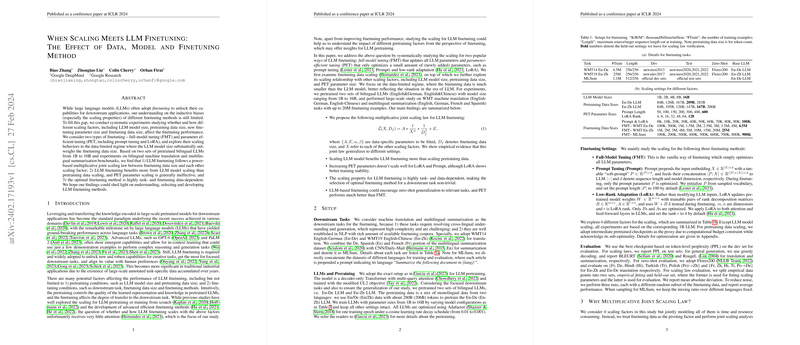Exploring the Dynamics of LLM Finetuning Across Scalable Parameters
Introduction to Finetuning Scaling in LLMs
In the rapidly evolving landscape of NLP, leveraging pretrained LLMs for downstream applications has established a new norm, capitalizing on in-context learning and emergent capabilities of models like GPT-4 and PaLM 2. Despite these advances, a systematic understanding of how various factors, particularly model size, pretraining data size, new finetuning parameters, and finetuning data size, influence the effectiveness of finetuning methods remains undeveloped. This gap in knowledge forms the crux of our investigation, focusing on two finetuning approaches: Full-Model Tuning (FMT) and Parameter Efficient Tuning (PET), the latter comprising methods like prompt tuning and Low-rank Option (LoRA).
Methodology and Experimentation
The research conducts a thorough analysis across multiple dimensions, involving LLM model sizes from 1B to 16B parameters and finetuning tasks including bilingual machine translation and multilingual summarization. The essence of this exploration is captured in a proposed multiplicative joint scaling law, articulating a relationship between finetuning data size and other scalars under paper, and highlighting:
- The relative impact of scaling LLM models versus pretraining data on finetuning efficiency.
- The limited effectiveness of scaling PET parameters.
- Task and data dependency in the selection of optimal finetuning methods.
- Enhanced zero-shot generalization to related tasks by PET over FMT.
Key Observations and Findings
The analysis brings forth several intriguing findings:
- LLM model size scaling significantly surpasses pretraining data scaling in benefitting finetuning performance, underlining the crucial role of model architecture complexity.
- In the field of PET parameter scaling, neither prompt tuning length nor LoRA rank scaling demonstrated substantial gains, with LoRA exhibiting better training stability.
- The paper corroborates the task and data-dependent nature of optimal finetuning method selection, arguing against a one-size-fits-all approach.
- Intriguingly, PET methods, particularly in the face of scant finetuning data, show a stronger propensity for zero-shot generalization, a key consideration for tasks where model flexibility is paramount.
Future Trajectories and Theoretical Implications
This investigation opens several avenues for future research, notably in extending these findings to multi-modal LLMs and understanding the impacts of finetuning data quality. The data-dependent joint scaling law proposed enriches our theoretical comprehension of finetuning dynamics in LLMs, laying groundwork for more optimized, task-specific application of these powerful models.
Concluding Remarks
The in-depth examination underscores the nuanced interplay between model size, data size, and finetuning methods in enhancing LLM performance on downstream tasks. By dissecting these relationships, this paper offers vital insights necessary for navigating the complexities of LLM finetuning, poised to influence future NLP research and application strategies significantly.
